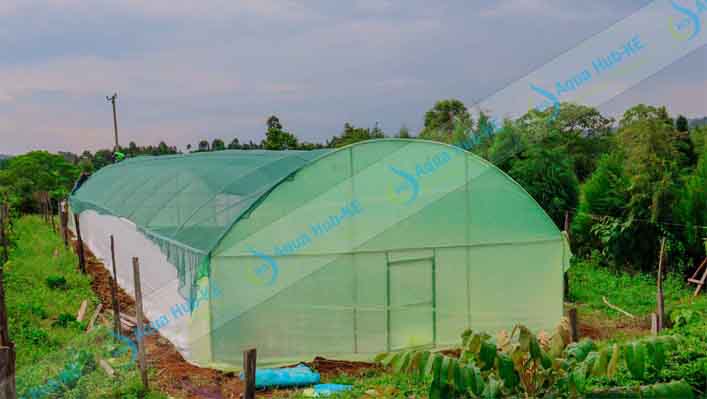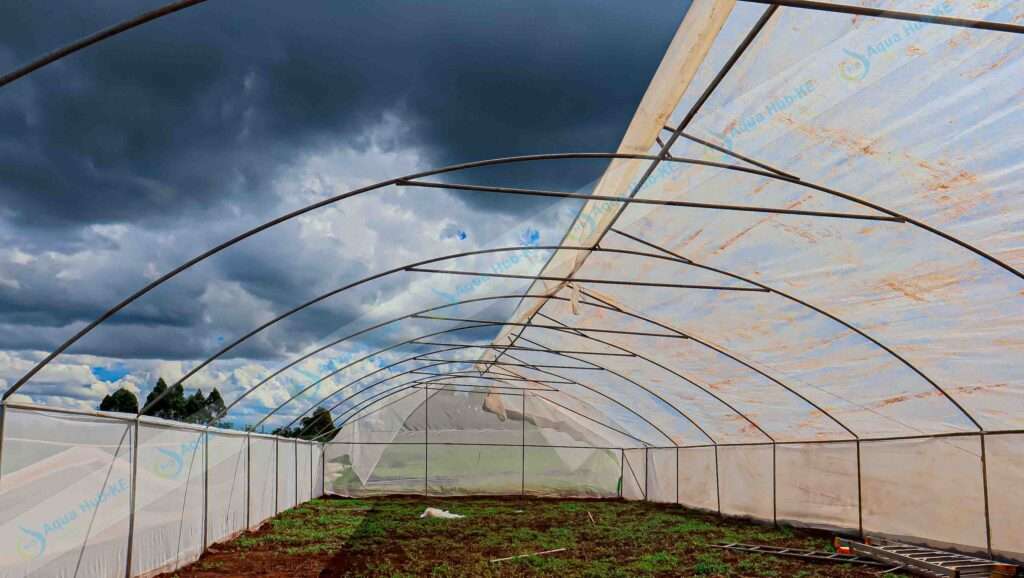Blog
how to get the right greenhouse sizes: 7 proven steps
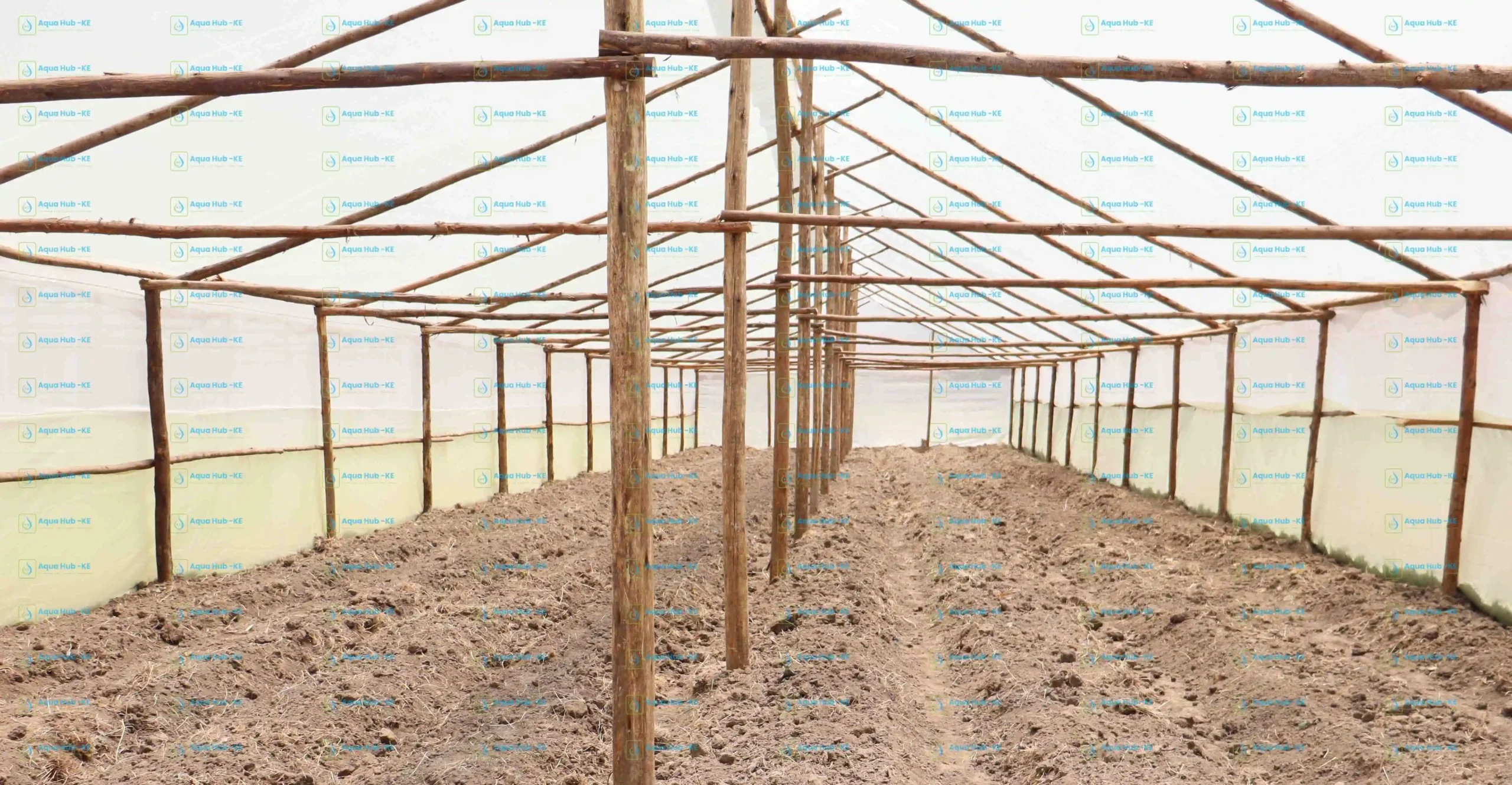
Greenhouse sizes in Kenya ranges from small unit measuring 120 square meters to large sizes that can exceed 720 square meters. The available greenhouse sizes are options made from Wooden or Metallic structure available at different costs. The cost of greenhouse sizes varies from KES 140,000 to more than KES 1,000,000.
In this guide, we have explained every greenhouse size and how to select a structure that meets your growing needs.
Understanding Greenhouse Sizes in Kenya: What Option Suits your growing Needs?
Common greenhouse sizes available in Kenya include 8m x 15m (120 square meters), 8m x 24m (192 square meters), 8m x 30m (240 square meters), 10m x 30m (300 square meters), and 16m x 30m (480 square meters) for both wooden and metallic structures.
These standard greenhouses are popular because construction costs are attainable and can fit different farm sizes and are ideal for many areas.
Every greenhouse size you choose serves different growing capacity. Common standard greenhouses are fit for:
8 x15 m: perfect for starters with low capital.
8 x 30 m: farmers who want to scale up their production capacity.
16 x 30 m: growers who are doing commercial crop production.
16 x 40m: commercial production. For individual, large-scale farmers and commercial groups with established export market niche.
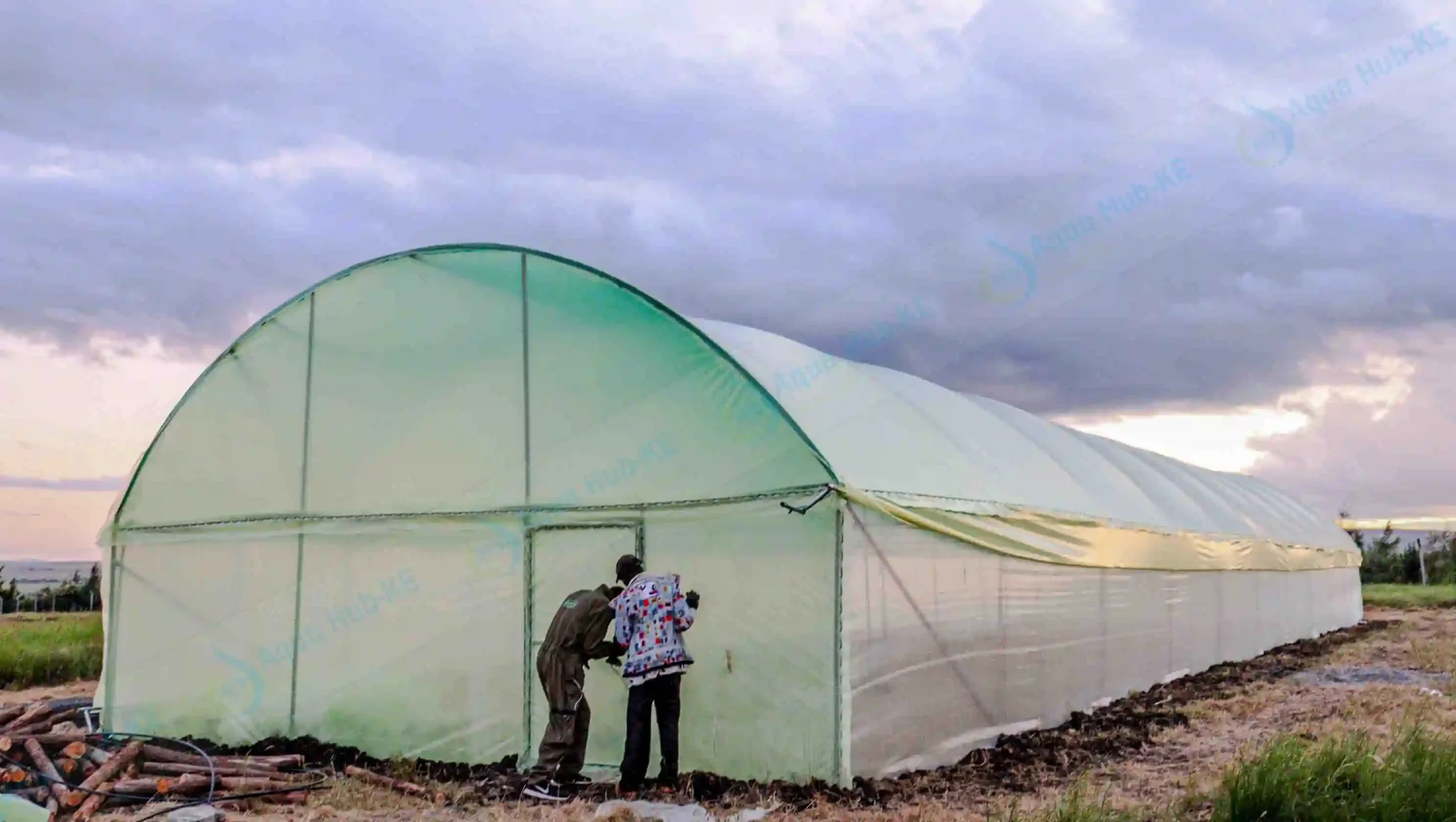
8 x 24 m metallic greenhouse

8 x 30 m metallic greenhouse sizes
Types of Greenhouses in Kenya: Design Impacts Sizes
Tunnel-Type Greenhouses
Tunnel greenhouse design features a hollow design made using galvanized steel frames and curved roof poles. Suitable for cold areas on high altitude regions often above 1800 meters. It’s ventilation is often a closable design for daytime opening and closing at night to regulate temperature.
Vented Greenhouses
Vent greenhouses feature a ventilation on the roof which regulates the inside growing conditions. Suitable for hot areas such as Mombasa, Kilifi, Ukambani among others.
Net Greenhouses
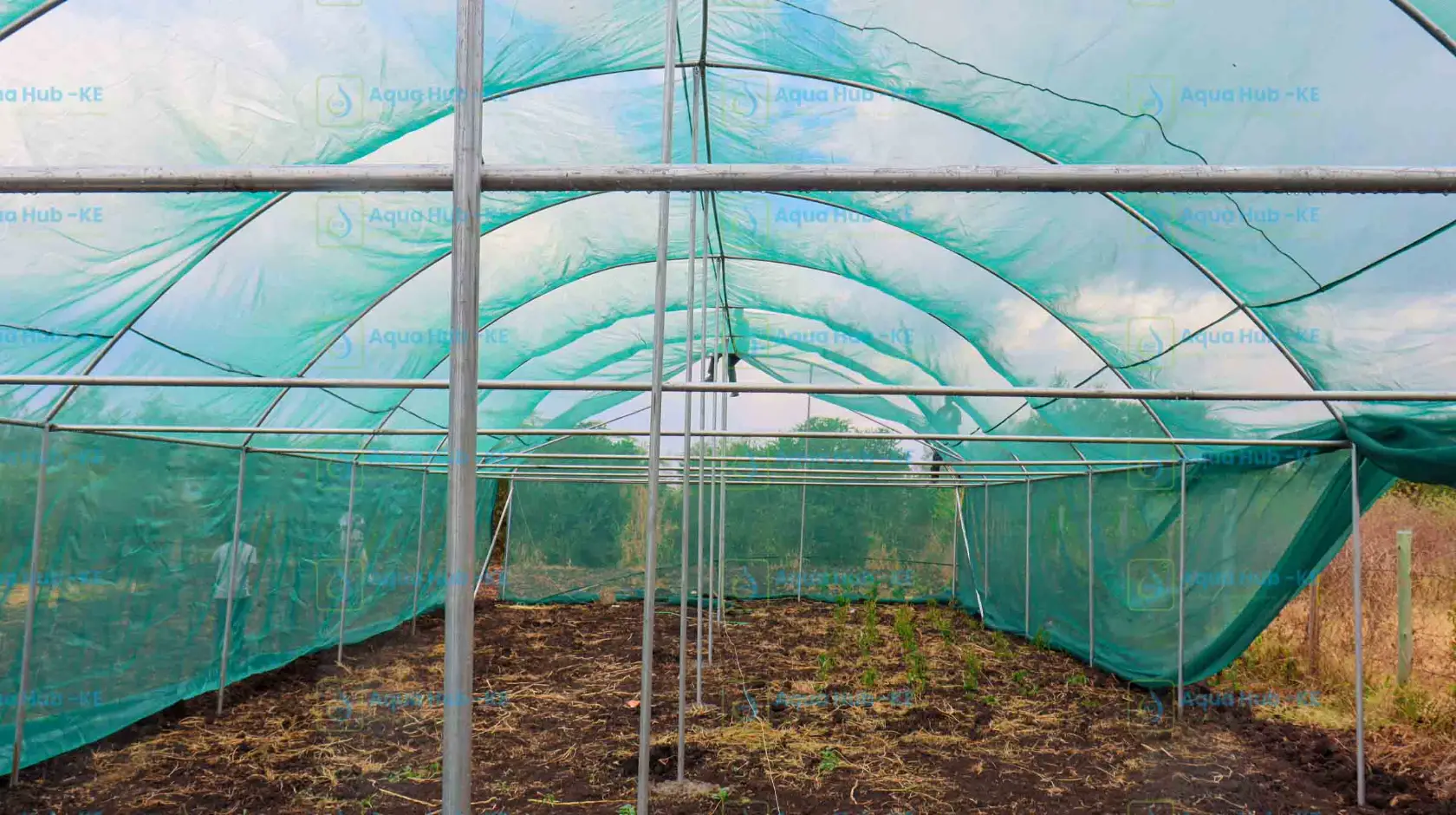
Construction of a net greenhouse
Net greenhouses offer an affordable alternative to fully enclosed polythene structures. They use shade nets instead of UV-treated polythene, providing protection from pests while allowing better airflow.
Net structures typically cost 30-40% less than equivalent polythene greenhouses, making them attractive for budget-conscious farmers growing crops that tolerate more environmental exposure.
These structures work well for leafy vegetables, herbs, and crops requiring less intensive climate control.
Factors that Determine the Ideal Greenhouse Sizes
Available Land Area
Your land size directly constrains greenhouse dimensions. The size of the greenhouse will be limited to the amount of land available to develop, with farmers with larger acreage designing larger structures and those with limited space doing smaller ones. However, don’t automatically fill all available space with greenhouse structures.
Water Availability
A grower must have sufficient irrigation water to grow the crop to maturity, as water availability affects greenhouse sizing decisions. Each tomato plant requires approximately 5-7 liters of water daily during peak production. An 8m x 30m greenhouse holding 500 tomato plants therefore needs 2,500-3,500 litres daily.
Calculate your water availability before finalizing greenhouse size. If you rely on borehole water, assess the daily pumping capacity and water table sustainability. Rainwater can supplement borehole or municipal water but require adequate storage capacity. A 1,000-liter tank is standard for small greenhouses, while larger operations need 5,000-10,000-liter capacity or more.
Budget and Financial Capacity
Greenhouse construction is a capital intensive, and the size of the greenhouse unit will be determined by your budget. Your budget must cover not just the structure itself, but also irrigation systems, crop support structures, inputs (seeds, fertilizers, pesticides), and operating capital for at least one full growing cycle.
Crop Type and Production Goals
Crop you are growing determines greenhouse design and size needed. Low-growing crops like strawberries, lettuce, herbs, and spinach can thrive in shorter structures (2-2.5 meters high), potentially reducing construction costs. Your target market also influences sizing decisions.
Export-oriented farmers need larger greenhouses to meet volume requirements and justify certification costs. Local market farmers can operate profitably with smaller structures.
Market Access
Local market vendors typically purchase smaller volumes, making small greenhouses economically viable. Supermarket contracts and export markets demand consistent large volumes, requiring medium to large greenhouse operations. Assess your market access realistically before committing to a greenhouse size you can’t profitably utilize.
Climate Conditions
Your location’s temperature, rainfall patterns, humidity levels, and wind conditions all influence optimal greenhouse sizing.
Cold areas like Nyeri require greenhouses with less ventilation while hot may need vented greenhouse for better air circulation.
Wind exposure affects structural requirements. Areas with strong prevailing winds need reinforced structures with appropriate orientation, potentially increasing costs for larger sizes.
Cost of Greenhouse Sizes in Kenya: Complete Cost Breakdown
Small Greenhouse Costs (8m x 15m to 8m x 24m)
Wooden Greenhouses (8m x 15m – 120 sq meters):
- KES 280,000-320,000 complete installation
- Includes: Timber frame, 200-micron UV polythene, insect nets, drip irrigation kit, entry pouch
- Lifespan: 3-6 years with proper maintenance
- Best for: Beginners, side ventures, testing greenhouse profitability
Metallic Greenhouses (8m x 15m – 120 sq meters):
- KES 150,000-180,000 for basic setup
- Includes: Galvanized steel frame, UV-treated polythene, basic irrigation
- Lifespan: 9-15 years
- Best for: Farmers planning long-term greenhouse operations
Medium Greenhouse Costs (8m x 30m to 10m x 30m)
8m x 30m Metallic Greenhouse (240 sq meters):
- Approximately KES 550,000 for complete installation
- Includes: galvanized steel, UV polythene covering, drip irrigation, insect nets, side rollup and entry pouch.
- Expected ROI: First-cycle tomato gross margin of roughly KES 1.3 million, paying itself back in under 24 months
- Best for: Serious commercial farmers, established operations
10m x 30m Metallic Greenhouse (300 sq meters):
- KES 650,000-750,000
- Includes: Enhanced ventilation, automated drip system, pest control nets
- Production capacity: 750-1,000 tomato plants
- Best for: Mid-scale commercial operations
Large Greenhouse Costs (16m x 30m and above)
16m x 30m Metallic Greenhouse (480 sq meters):
- KES 1,800,000-1,900,000 for premium commercial setup
- Includes: Heavy-duty steel frame, automated systems, climate control
- Production capacity: 1,200-1,600 tomato plants
- Best for: Export-oriented farms, large commercial operations
16m x 45m Metallic Greenhouse (720 sq meters):
- KES 1.35 million-1.48 million
- Includes: Complete automation capability, advanced ventilation systems
- Requires: Professional farm management, skilled labour team
- Best for: Established commercial farms, flower production for export
Additional Cost Considerations
Beyond the base structure, budget for these essential additions:
Irrigation Systems:
- Automated drip irrigation systems range from KES 50,000 to KES 150,000 depending on size and sophistication
- Manual systems: KES 30,000-50,000 for small greenhouses
- Fertigation systems: Add KES 80,000-120,000
Climate Control:
- Heating and cooling systems cost between KES 20,000 and KES 100,000
- Automated ventilation: KES 70,000-110,000 for mid-range systems
- Temperature monitoring: KES 15,000-30,000
Pest Management:
- Pest control measures like nets and sprays can add an additional KES 10,000 to KES 50,000
- Yellow sticky traps and monitoring systems: KES 8,000-15,000
- Insect screening upgrades: KES 20,000-40,000
Profitability Analysis: Expected Returns by Greenhouse Sizes
Small Greenhouse (8m x 15m – 120 sq meters):
- Tomato plants: 300-350 plants
- Expected yield: 15-20 kg per plant over 6 months
- Total production: 4.5-7 tons
- Revenue at KES 50-110 per kg: KES 225,000-770,000
- Production costs: KES 150,000-200,000
- Net profit: KES 75,000-570,000 per cycle
- ROI timeline: 2-4 cycles to recover initial investment
Medium Greenhouse (8m x 30m – 240 sq meters):
- Tomato plants: 600-750 plants
- Expected yield: 15-20 kg per plant
- Total production: 9-15 tons
- Revenue potential: KES 600,000-1,300,000
- Production costs: KES 300,000-400,000
- Net profit: KES 300,000-900,000 per cycle
- ROI timeline: Under 24 months with proper management
Large Greenhouse (16m x 30m – 480 sq meters):
- Tomato plants: 1,200-1,500 plants
- Expected yield: 15-20 kg per plant
- Total production: 18-30 tons
- Revenue potential: KES 1,400,000-3,300,000
- Production costs: KES 600,000-800,000
- Net profit: KES 800,000-2,500,000 per cycle
- ROI timeline: 12-18 months for experienced farmers
What Affects Profitability of Greenhouses in Kenya
Crop Selection: High-value crops like capsicum, cucumbers, tomatoes, strawberries, and specialty herbs offer better profit margins than regular vegetables like kale and spinach. Coloured capsicum can fetch KES 150-250 per kg compared to tomatoes at KES 50-110 per kg, significantly impacting profitability per square meter.
Production Efficiency: Proper irrigation, pest management, and fertilization directly affect yield quality and quantity. Greenhouse yields can be 2-3 times higher than open field production when managed correctly. Poor management can reduce this advantage significantly, making smaller, well-managed greenhouses more profitable than larger, poorly managed structures.
Market Timing: Producing during off-peak seasons when supply is low allows farmers to command premium prices. A medium greenhouse supplying tomatoes during traditionally dry seasons can earn 40-60% higher revenues than peak season production.
Quality Standards: Meeting supermarket or export quality standards unlocks higher-value markets. This often requires investing in better greenhouse infrastructure, favoring slightly smaller greenhouses with superior specifications over larger budget structures.
Step-by-Step Guide: Choosing Your Greenhouse Sizes
Step 1: Assess Your Financial Capacity
Don’t strain your budget much. It’s better to build a smaller greenhouse with proper equipment and operating capital than a large structure you can’t maintain.
Step 2: Evaluate Your Land
Measure your available land precisely while considering space for future expansion. For example, a quarter-acre plot can realistically accommodate an 8m x 30m greenhouse plus necessary infrastructure.
Soil tests are important to determine the growing needs of your greenhouse structure. For example, if your soil is infected you need to use grow bags. In case of high acidity, you would need lime.
Step 3: Calculate Water Requirements
Assess your water source reliability and capacity. A borehole should sustain at least 5,000 litres daily for a medium greenhouse. You can boost your water supply by collecting rainwater for use in times of water shortage.
Step 4: Assess Your Market Options
Research your target market thoroughly. Engage with potential buyers, supermarkets, hotels, wholesalers, exporters to understand their volume requirements, quality standards, and pricing. For example, a supermarket contract requiring supply of 500kg capsicum every week would not be met with an 8m x 15m greenhouse.
Step 5: Consider Your Experience Level
First-time greenhouse farmers should start with 8m x 15m or 8m x 24m structures. This size allows you to learn greenhouse management irrigation timing, pest control, temperature regulation, pruning techniques without risking much capital. Experienced open-field farmers can consider 8m x 30m as a starting point.
Farmers with prior greenhouse experience can confidently scale to medium or large structures, leveraging their knowledge for better management outcomes. Consider hiring experienced greenhouse technicians if jumping to large-scale operations without prior experience.
Step 6: Factor in Climate Conditions
In cool highlands, build tunnel-type greenhouses to retain heat during cold nights, while in warm lowlands, construct vented types to moderate high daytime temperatures. Highland locations can operate efficiently with smaller ventilation openings, potentially reducing costs. Hot regions need taller structures (3.5-4 meters) for better heat dissipation.
Step 7: Plan for Future Expansion
Many successful farmers start with one 8m x 30m greenhouse, learn and refine operations, then add identical units once profitability is established. This staged approach reduces risk while allowing systematic scaling. Budget for eventual expansion even if implementing small initially.
Greenhouse Size Selection Strategies
Strategy 1: Modular Expansion Approach
Start with a single 8m x 15m or 8m x 30m greenhouse positioned to allow future additions. Use the first unit to develop skills, test markets, and generate cash flow. Once profitable and experienced, add identical units using proven designs and systems. This approach minimizes initial risk while facilitating systematic scaling.
Strategy 2: Mixed-Size Portfolio
Use multiple greenhouse sizes for different growing purposes. Use a small 8m x 15m unit for seedling propagation and experimentation, medium 8m x 30m structures for main production, and potentially larger units for established, proven crops. This diversification reduces risk while optimizing each structure’s purpose.
Strategy 3: Seasonal Sizing Adjustment
In regions with distinct wet and dry seasons, consider net greenhouses for wet seasons and polythene structures for dry seasons. Net structures cost significantly
Frequently Asked Questions
1: What are the most common greenhouse sizes available in Kenya?
8m x 15m, 8m x 24m, 8m x 30m, 16 x 24m, 10m x 30m, and 16m x 30m.
2: How much does a greenhouse cost in Kenya in 2025?
The cost starts from KES 140,000 to KES 700,000 or more depending on the size and type.
3: Should I choose a wooden or metallic greenhouse for my farm?
The choice between wooden and metallic greenhouses depends on your budget, location, and long-term plans.
4: What factors should I consider when choosing my greenhouse size?
Land, availability of water, climate conditions, and market.
5: What is the difference between tunnel-type and vented greenhouses?
Tunnel type greenhouses contain ventilation on the sides while vented types have ventilation on the roof. Vented greenhouses cost more than tunnel type.
6: How many plants can I grow in a greenhouse?
The number of plants depends on greenhouse size, crop type and spacing.
| Crop type | 8 x 15m | 8 x 24m | 8 x 30m | 16 x 30 m |
| Tomato | 300 – 500 | 480 – 600 | 600 – 1000 | 1200 – 1600 |
| Capsicum | 350 – 400 | 500 – 560 | 700 – 800 | 1400 – 1600 |
| Cucumber | 250 – 300 | 400 – 450 | 500 – 600 | 1000 – 1200 |
7: How profitable is greenhouse farming in Kenya?
Profitability of greenhouse cultivation depends on the crops grown, production costs, scale of production and quality of the produce.
8: What crops are best suited for greenhouse farming in Kenya?
Tomatoes, strawberries, capsicum, herbs, cucumbers, flowers and Herbs thrive in greenhouse environment.
9: Can I start greenhouse farming with a small budget in Kenya?
Yes, greenhouse farming is accessible to farmers with limited budgets starting from as low as KES 100,000 – 165,000.
10: How do I determine the right greenhouse size for my specific location in Kenya?
Choosing the right greenhouse size requires matching your structure to local conditions. Use a vented design and a tunnel design for cold places.

